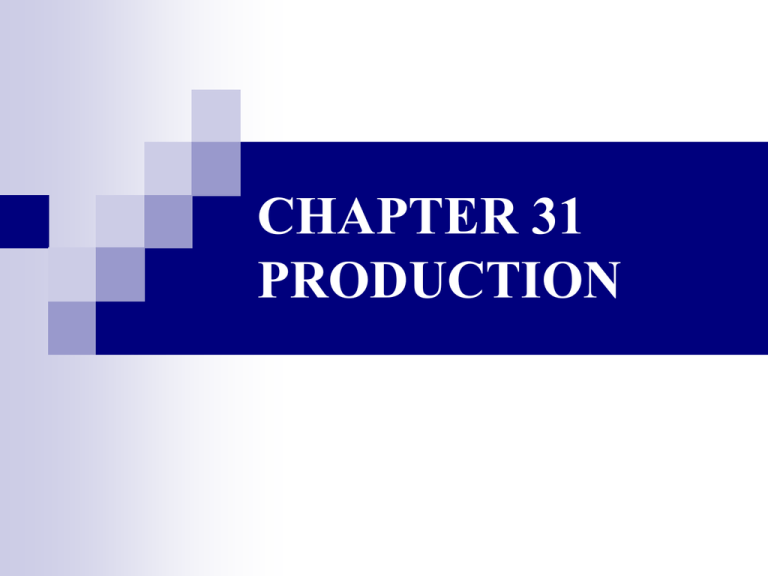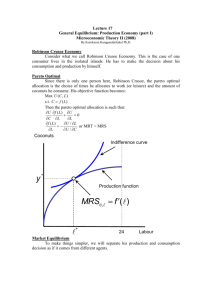chapter 31 production
advertisement

CHAPTER 31 PRODUCTION The Robinson Crusoe Economy One consumer and one firm; The consumer owns the firm; Preference: over leisure and coconuts; Technology: use leisure to produce coconuts; The planner’s problem: max u (C , l ) s.t. C f ( L) l L L C, l F.O.C. u l u f ( L) C The Robinson Crusoe economy The Competitive equilibrium Labor market and goods market; The consumer supplies labor and buys consumption goods from markets; The firm hires labor and sells output in markets; Utility maximization and profit maximization; General equilibrium on both markets; The consumer is the shareholder of the firm. The Competitive equilibrium The firm’s behavior: max f ( L) wL L F.O.C. f ( L) w The firm’s profits: * C * wL* The Competitive equilibrium The Competitive equilibrium The consumer’s budget constraint: C wl wL * The consumer’s problem: max u (C , l ) s.t. C wl wL C ,l F.O.C. u l u w C * The Competitive equilibrium The Competitive equilibrium The competitive outcome is Pareto efficient. u l u w f ( L) C The Competitive equilibrium Different Technologies Constant returns to scale Zero profits for the firm; The isoprofit coincides with the production function; The budget line coincides with the isoprofit; The competitive equilibrium is Pareto efficient. Different Technologies The competitive equilibrium exists. Different Technologies Increasing returns to scale The Pareto efficient allocation cannot be achieved by the competitive market. The firm would be making negative profits at the Pareto efficient allocation; Given any market price, the profit-maximization problem has no solution. Different Technologies The Pareto efficient allocation is not attainable. The 1st and 2nd theorem of welfare economics Assuming convexity and closedness, the competitive equilibrium exists; The competitive equilibrium is Pareto efficient; Assuming convexity, any Pareto efficient allocation can be achieved by a competitive equilibrium. Production possibilities One input, multiple output; Production possibility set: set of feasible outputs; Production possibility frontier: set of efficient outputs; Marginal rate of transformation: the rate at which the economy substitutes one output for another. Production possibilities Comparative Advantage Robinson Crusoe: FC/10+CC/2010; Friday: FF/20+CF/1010; Robinson has a comparative advantage in coconuts and Friday has a comparative advantage in fish. Comparative Advantage Comparative Advantage Joint production possibility set: FC CC 10; 10 20 FF CF 10. 20 10 F 3 C 300 FC 300 if 2 2 C 3 F 300 CF 300 if 2 2 FC 0; CF 0. Comparative Advantage Pareto efficiency Given total output (x1, x2), the competitive equilibrium is given by MRSA=MRSB. We must have MRSA=MRSB=MRT; The slope of indifference curves at the competitive equilibrium must equal the slope of the PPF at (x1, x2). Pareto efficiency Competitive Equilibrium Assuming inelastic supply of labor: LC+LF=L; The firm’s problem: max pC C pF F L C,F F.O.C. pF MRT pC Competitive Equilibrium The firm chooses a point on the PPF that maximizes its profits given prices. Competitive Equilibrium The consumer’s problem: max u(C, F ) s.t. pC C pF F wL C, F F.O.C. pF MRS pC





